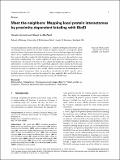Meet the neighbours: mapping local protein interactomes by proximity-dependent labelling with BioID
Abstract
Proximity-dependent biotin identification (BioID) is a recently developed method that allows the identification of proteins in the close vicinity of a protein of interest in living cells. BioID relies on fusion of the protein of interest with a mutant form of the biotin ligase enzyme BirA (BirA*) that is capable of promiscuously biotinylating proximal proteins irrespective of whether these interact directly or indirectly with the fusion protein or are merely located in the same sub-cellular neighbourhood. The covalent addition of biotin allows the labelled proteins to be purified from cell extracts on the basis of their affinity for streptavidin and identified by mass spectrometry. To date, BioID has been successfully applied to study a variety of proteins and processes in mammalian cells and unicellular eukaryotes and has been shown to be particularly suited to the study of insoluble or inaccessible cellular structures and for detecting weak or transient protein associations. Here, we provide an introduction to BioID, together with a detailed summary of where and how the method has been applied to date, and briefly discuss technical aspects involved in the planning and execution of a BioID study.
Citation
Varnaitė , R & MacNeill , S A 2016 , ' Meet the neighbours: mapping local protein interactomes by proximity-dependent labelling with BioID ' , Proteomics , vol. 16 , no. 19 , pp. 2503-2518 . https://doi.org/10.1002/pmic.201600123
Publication
Proteomics
Status
Peer reviewed
ISSN
1615-9853Type
Journal item
Collections
Items in the St Andrews Research Repository are protected by copyright, with all rights reserved, unless otherwise indicated.

